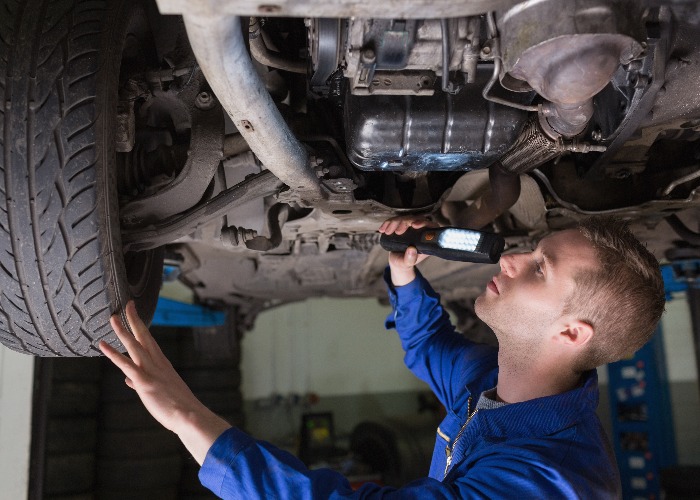Failed MOTs: dirty cars, windscreen obstructions, damaged registration plates, dashboard warning lights

With more than a third of cars failing their initial MOT, Katy Ward reveals nine little-known things that could land you in trouble with an examiner.
Many motorists dread their MOT rolling around every year.
Not only does the test set you back up to £54.85, there’s always that stomach-churning feeling that your car won’t be up to standard.
And it seems there is reason to be concerned as government figures reveal that approximately 37% of vehicles don’t pass muster on their initial test.
We all know that dodgy tyres and faulty brakes are a major no-no on the inspectors’ checklist, but what else can cause your car to fail?
In this article, we look at nine little-known reasons that your car may not make it through its MOT.
Best and worst car insurers revealed
1. A hanging air freshener
If your car’s air freshener obstructs your vision, this could give the examiner sufficient reason to fail your vehicle as they may deem your car unsafe to drive.
And this rule doesn’t just apply to air fresheners as obstructions on your dashboard such as satnavs or phone holders can also result in a failed test.
Be aware, the rules state that you should inform your examiner if you have removed any items from your rear-view mirror or dashboard before the test.
2. A dirty car
While you might think that it’s none of your assessor’s business if your car is messy or unclean, you could well be mistaken.
If any clutter in your car causes an obstruction, this could become a safety hazard and cause you to fail the test. For example, discarded containers on the floor could prevent you from safely reaching the pedals.
In fact, the assessor has the right to refuse to conduct the test if they believe your vehicle is extremely unclean.
Cheap fuel: how to save every time you fill up
3. A damaged number plate
According to rules from the Driver and Vehicle Standards Agency (DVSA), your car’s number plate should not be ‘obscured, excessively damaged deteriorated or delaminated’.
The regulation also states that the number plate should be the first thing that your examiner checks when conducting the test.
Common reasons to fail include a plate that is likely to fall off or has an illegible registration number.
However, you may also fall foul of the rules if your car has a non-standard number plate.
This could include having something attached to your number plate that changes its appearance or having a honeycomb background (although the point relating to backgrounds only applies on vehicles registered after September 2001).
4. Dashboard warning lights
For many of us, dashboard warning lights can be something of a nuisance that we tend to ignore.
However, these lights will need to be in working order if you’d like a passing grade on your MOT.
Before you take your car in for inspection, it’s sensible to run a check on all your warning lights yourself.
If you notice that any aren’t working correctly, you should have this rectified before the test.
Ignoring these warning lights could cost you £3,000
5. A dodgy driver’s seat
When it comes to safety on the roads, a driver’s seat isn’t simply a matter of comfort for motorists.
If your seat is extremely worn or unstable, it may be difficult to fully control your vehicle, which could result in an MOT failure.
6. Suspension problems
Like a driver’s seat, the suspension in a car is about more than pure comfort.
In fact, having a functioning suspension is key to the safe operating of any car as this allows you to properly control your vehicle.
If yours is defective, there’s a good chance your car won’t make it through the inspection.
Car giving you too many issues? See how much you could get by selling it quickly through Motorway (affiliate link)
7. A defective horn
Although some of us rarely use our horns, these are intended as an integral safety feature, especially in an emergency.
Your examiner will have grounds to fail your car if your horn isn’t functioning properly or doesn’t emit a loud enough blast to alert other road users to your presence.
8. Insufficient windscreen fluid
Having functioning windscreen wipers is obviously essential for the safe running of any car.
It goes without saying that you need to be able to have a clear view of the road when you’re driving.
And according to the MOT’s assessor’s handbook, wipers cannot be deemed to work effectively without enough fluid.
9. Incorrect headlight beam aim
When assessing your vehicle, an examiner will need to check that your headlamps are in the correct position.
If the headlights are too high or too low, their beam could potentially dazzle oncoming drivers and pose a safety hazard.
Interestingly, the rule surrounding headlight beams changed in 2015 when the DVSA identified this as one of the items most likely to be incorrectly assessed by testers.
Prior to the rule changes, the DVSA felt that too many examiners had conducted little more than a quick check.
Car giving you too many issues? See how much you could get by selling it quickly through Motorway (affiliate link).
Comments
Do you want to comment on this article? You need to be signed in for this feature